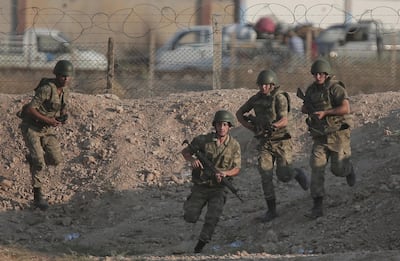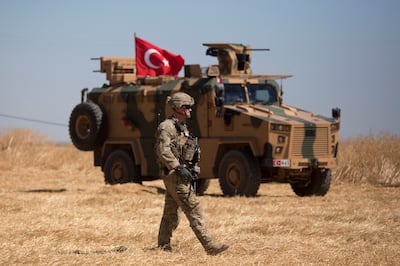SALT LAKE CITY — President Donald Trump’s Sunday evening announcement of his intent to withdraw all U.S. ground troops from Syria went over like a lead balloon.
High-ranking military officers, security analysts, and congressmen from both sides of the aisle, including Utah Sen. Mitt Romney, have decried the announcement. Much has been made of the possible repercussions: enabling a resurgent ISIS, ceding territory and influence to global competitor Russia, strengthening regional enemy Iran and even emboldening Turkey. All are likely to happen as the other powers with a stake in the conflict rush to fill the vacuum.
The announcement shouldn’t come as a total surprise. This is the second time Trump has announced his intent to remove troops from Syria. Last December he tasked then-Secretary of Defense James Mattis to have the military draft up specific plans — to similar shock of military leaders and lawmakers. However, the timing of this announcement and the fact that Trump also announced that Turkey would soon be invading northern Syria is the real stunner.
The U.S. has an alliance problem. Two of its most important allies in the region are next-door neighbors who hate each other: the Turks and the Kurds. Both have been important to U.S. policy for decades.

Turkey, the southernmost member of NATO and a long-time bulwark against Soviet and now Russian designs on the Mediterranean and the Middle East, continues to be critical to U.S. strategies in the region. More and more, those strategies look like the Cold War policy of containment, as Russian President Vladimir Putin acts aggressively across the Black Sea and the Middle East, including in Syria.
The Kurds are a sub-state ethnic group that has been a vital operational ally, starting during the 2003 invasion of Iraq. They have arguably been the most important U.S. ally in the fight against ISIS and have worked closely with the U.S. military presence in Syria, known as Operation Inherent Resolve. Today, the Syrian Kurds, or YPG, anchor a loose confederation of military units called the Syrian Democratic Forces, or SDF. They control what has arguably been the most stable region in the country — which abuts the Turkish border in northern Syria.
The trouble is that the Kurds and Turkey are natural enemies. The Kurds ache for a homeland, an independent Kurdistan somewhere, anywhere. But ideally, a Kurdish state would encompass eastern Turkey, northeastern Syria, northern Iraq and parts of western Iran — the historical homeland for the Kurdish people. Turkey feels that pressure in its eastern territory and has battled Kurdish separatists in their own country under the guise of the PKK, or Kurdistan Workers Party. Turkey has designated the organization, which has waged a guerrilla war in eastern Turkey for decades, as a “terrorist group.”
In 2000, I traveled across eastern Turkey, through areas contested by the Kurds. My escort was a Turkish special forces unit. Nearly every town and city we passed through was occupied by Turkish troops. Armored vehicles and machine-gun emplacements watched all the critical intersections while Turkish troops patrolled the streets. There is a real and ongoing fight between the Kurds who seek independence and the Turkish state, which is fully committed to maintaining its territory.
The animosity bred by this conflict has directly impacted the U.S. in the past. During the invasion of Iraq in 2003, the U.S. planned to send the 4th Infantry Division into northern Iraq through Turkey, establishing a second front for Iraqi troops to contend with. Turkey refused, so the 4th Infantry Division had to ship its equipment out of the Mediterranean Sea, through the Suez Canal and up the Persian Gulf. The delay put the 4th Infantry Division out of business for the initial invasion, so the U.S. had to rely on small numbers of special forces, linking up with Kurdish fighters to seal off northern Iraq while the 3rd Infantry Division, the 101st Air Assault Division and the 1st Marine Expeditionary Force invaded from the south. This was less than ideal.

That may not have been the only time Turkey prioritized its own interest over its alliance with the U.S. In 2004, when I was in Mosul, an Iraqi city divided between Kurds and Arabs, a member of a U.S. special operations unit told me his team had run into Turkish special forces operating in northern Iraq “against Kurdish targets.” According to the U.S. source, his unit had escorted the Turks out of the country. While I have no direct proof, I heard other similar anecdotes in Iraq about Turkish military units operating in Iraqi Kurdistan.
Pulling the U.S. military out of northern Syria basically abandons the Kurds to their mortal enemy. This should also sound familiar. The U.S. paid lip service to the Kurds but passively stood by when they were gassed by Saddam Hussein’s regime in 1988, though that chemical warfare attack was later used as partial pretext for the invasion of Iraq in 2003. In 1990-1991, in the events surrounding the First Gulf War, the U.S. encouraged Kurds to rise up against Hussein, then failed to support them when they did. The Kurds paid dearly. In the aftermath, the U.S. tried to mitigate this failure by establishing a no-fly zone to protect Kurds against the Iraqi air force, but the damage was done. President Trump’s announcement is another demonstration of the U.S. failure to stand with its Kurdish partner.
If U.S. troops do leave Syria, Turkey may want to be careful what it asks for. The Syrian Kurds have nowhere else to go and it is very likely that a Turkish invasion will be met with fierce Kurdish resistance. The Kurds have proven to be a formidable force and while sheer numbers and capability favor the Turks, it will not be an easy fight.
Meanwhile, the U.S. serves up one important ally to another important ally. This isn’t good long-term policy.
Dodge Billingsley is the director of Combat Films & Research and a military analyst with more than 25 years’ experience covering conflict and global hot spots. He is based in Salt Lake City.

